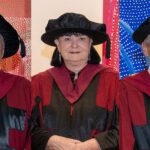C207/08
22 July 2008
In a first for Curtin University of Technology’s forensics team, the ABC program “Can we help You” will use Curtin’s innovative research into forensic techniques that expose forgery to illustrate some of the advantages of using the Australian Synchrotron facility in Melbourne.
The program will demonstrate how a carelessly written cheque can be forged and then exposed as a forgery by examining it with a Synchrotron generated infrared beam.
Professor Bill van Bronswijk explained the process.
“A synchrotron is a machine that accelerates electrons to almost the speed of light and as the electrons are deflected through magnetic fields they create extremely bright light The light is channelled down beamlines to experimental workstations where it is used for research,” Professor van Bronswijk said.
Synchrotron light is unique in its brilliance and narrow focus, and can be generated across the range of the electromagnetic spectrum: from infrared to x-rays. This gives it a distinct advantage over conventional light sources for applications ranging from finding poison traces after an unexplained murder, characterising inks and pigments in documents and artworks, distinguishing characteristics of automotive paint pigments in hit-and-run car accidents to detecting explosives or illegal drugs on clothing.
“Infrared techniques are useful to identify inks and pigments in forgeries and counterfeit banknotes. The demonstration will use a cheque, made out to myself for ‘seven thousand dollars only’. Using a different ink, a ‘one’ was added before the ‘seven’ and the ‘seven’ became ‘seventeen’, thereby creating the forged cheque,” Professor van Bronswijk said.
“We should be able to see the difference in the inks and possibly even pick the part of the ‘t’ that was written over part of the ‘n’.”
Professor Roland de Marco, Dean Research and Development for Science and Engineering, outlined the advantages of Curtin’s Australian Synchrotron foundation membership, held in conjunction with the Department of Industry and Resources (DOIR) and The University of WA (UWA) and offering significant beam time.
“Curtin has utilised 120 hours across the four operational beamlines during the past year, which is part of their contractual agreement as one of the founding members,” Professor de Marco said.
“Our undergraduate and postgraduate students as well as staff are able to take full advantage of the high brightness of the synchrotron to undertake unique experiments such as the high resolution imaging of bones and tissues, the analysis of forensic evidence such as hair on poisoned victims, and a monitoring of the maturation of human eggs adopted in in vitro fertilisation (IVF). The brightness of the beam is the key factor that enables success with these otherwise difficult and challenging experiments.”
The program “Can we help You” goes to air on the ABC at 6.30pm on Friday 25th July.
Contact: Professor Roland de Marco, 08 9266 7322, r.demarco@curtin.edu.au or Lisa Mayer, PR Coordinator, Curtin, 08 9266 1930, 0401 103 755 l.mayer@curtin.edu.au
CRICOS provider code: 00301J
Modified: 22 July 2008


